Asparagus Risotto
Risotto...With Asparagus
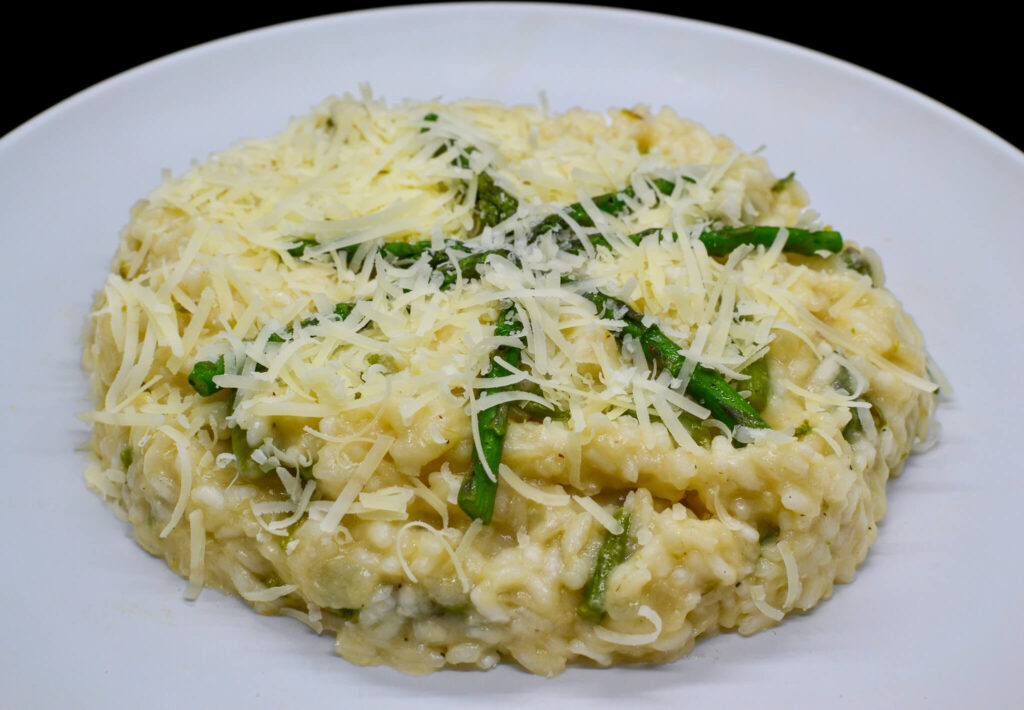
What Is Asparagus Risotto?
Asparagus risotto is a traditional Italian dish from Northern Italy. It’s made by cooking rice with broth until creamy and adding asparagus. This dish became popular because it’s easy to make and uses fresh, local ingredients like asparagus, a common spring vegetable.
Ingredients For Asparagus Risotto
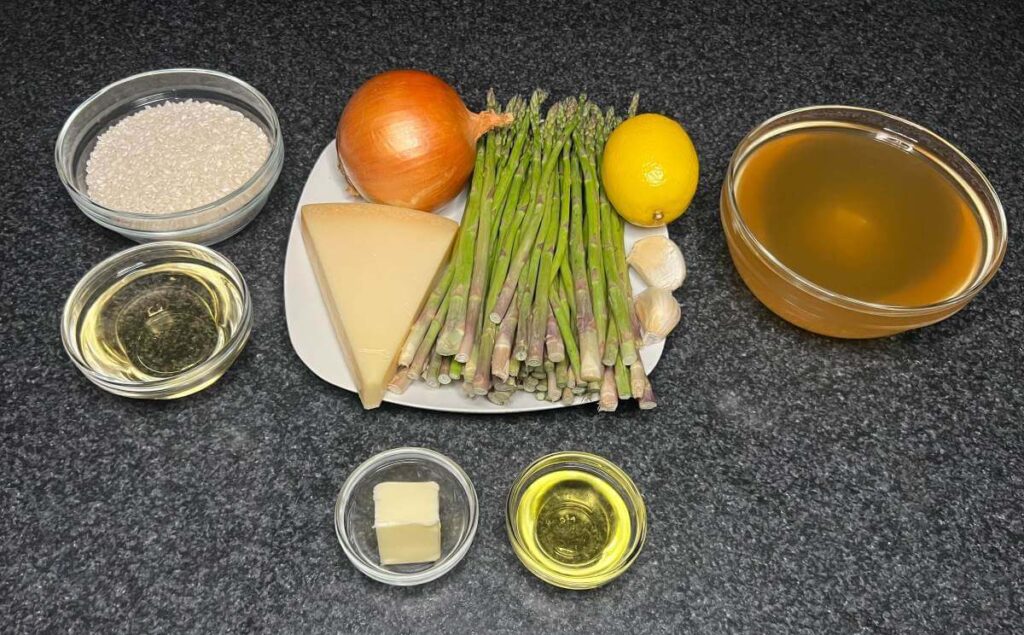

Produce
1 Pound Asparagus
1 Lemon
1 Sweet Onion
2 Cloves of Garlic
Refrigerated
1/2 Cup Parmesan Cheese
2 Tbsp Butter

Grocery
2 Cups Arborio Rice
3/4 Cup White Wine
4 Cups Vegetable Stock
4 Tbsp Olive Oil

Spices
1/2 tsp Salt
1/2 tsp Black Pepper
How To Make Asparagus Risotto
Step 1
Prep & Cook Asparagus
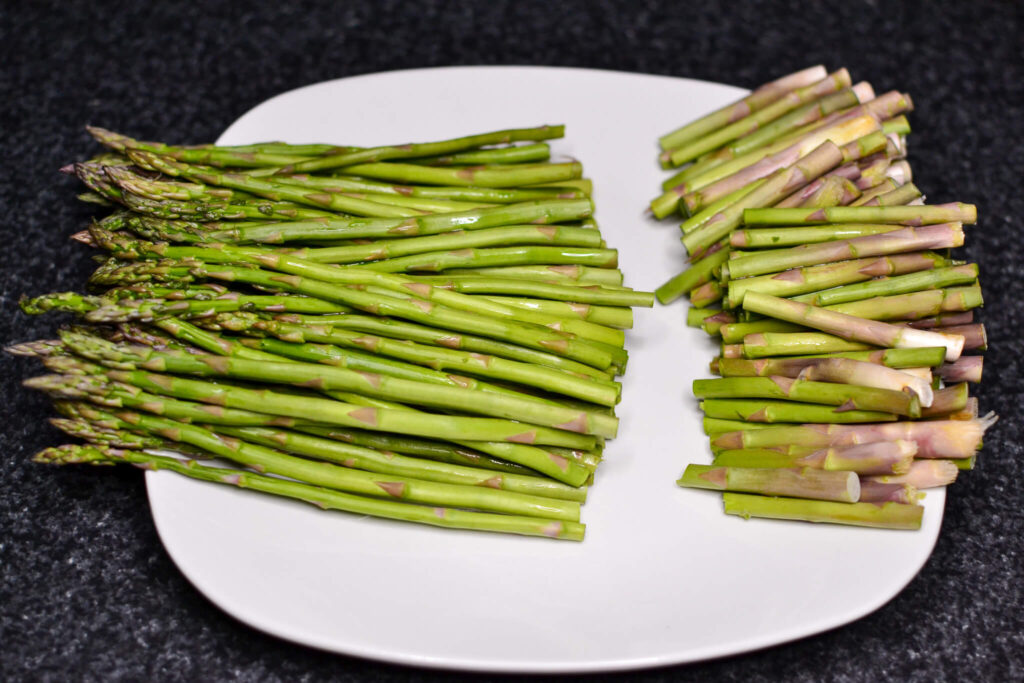
Selecting quality asparagus is crucial for this dish. Look for firm, brightly colored stalks that feel heavy for their size, as these are indicators of freshness and good flavor. Asparagus is not only a key ingredient in our recipe but also a nutritious spring vegetable with a rich history.
Trimming asparagus is easy. Each stalk bends at a point where the soft part meets the hard end. Bend the asparagus and it will break right at that spot, giving you the best part to cook. To make it quicker, find the bending point on one stalk, line up the rest, and cut them all at the same spot in one go.
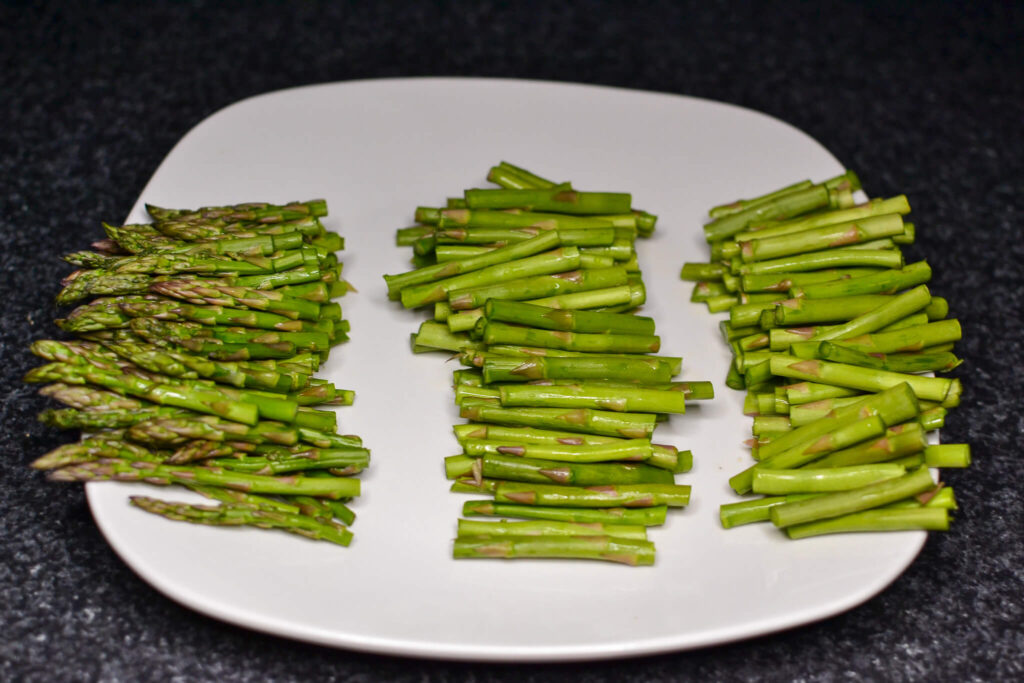
Chop the asparagus into three equal parts. This specific size helps each piece cook evenly and mix well with the risotto.
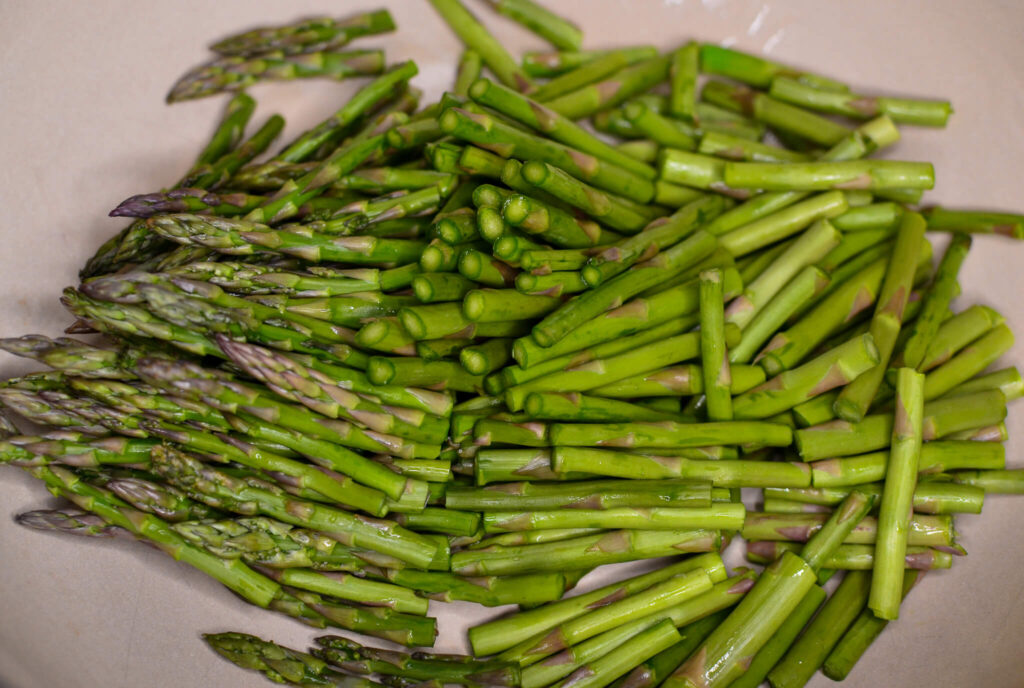
Begin to sauté the asparagus, heat butter and olive oil in a pan on medium heat for flavor and to prevent burning. Cook the asparagus for 3-5 minutes until it changes color, which enhances its taste.
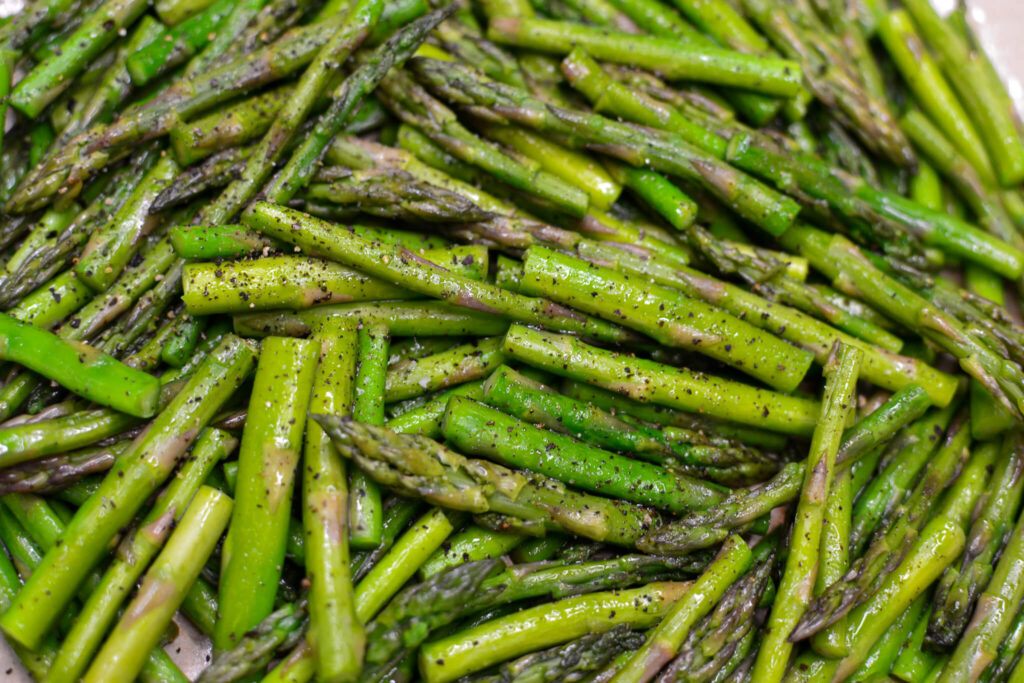
Season with salt and pepper. This step is crucial, as it enhances the natural flavors of the asparagus, making them more pronounced against the creamy backdrop of the risotto.
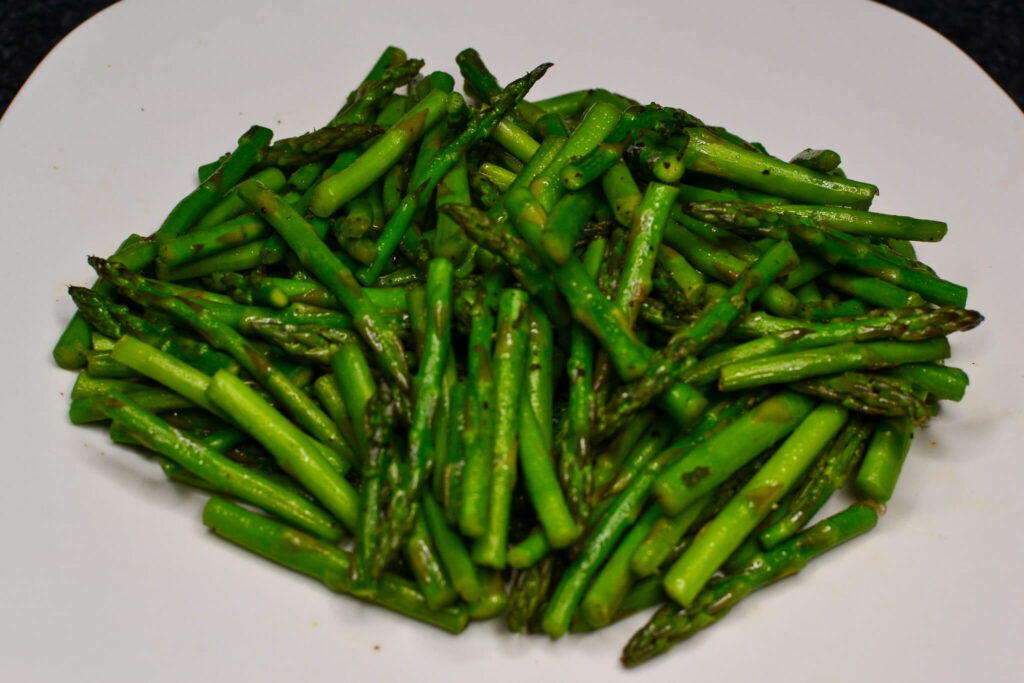
Once done, set them aside. This not only prevents overcooking but also allows you to reintroduce them at the perfect moment to maintain their texture and flavor.
Step 2
Prep & Cook Onions/Garlic
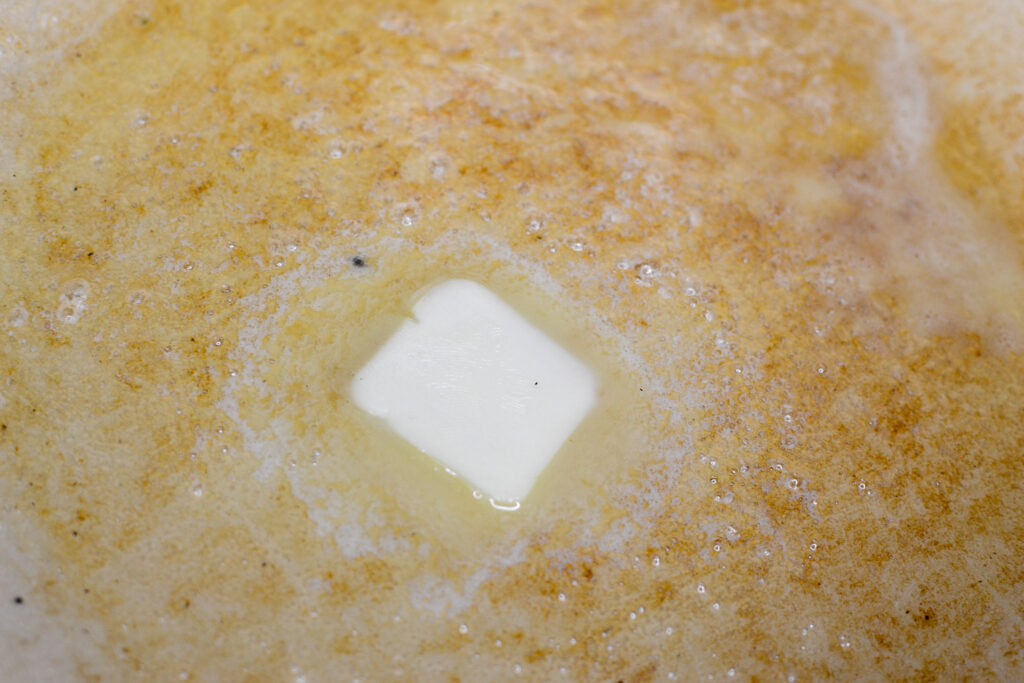
Using the same pan, add more butter and olive oil. This layering of flavors is a fundamental principle in cooking, creating a rich base for the other ingredients.
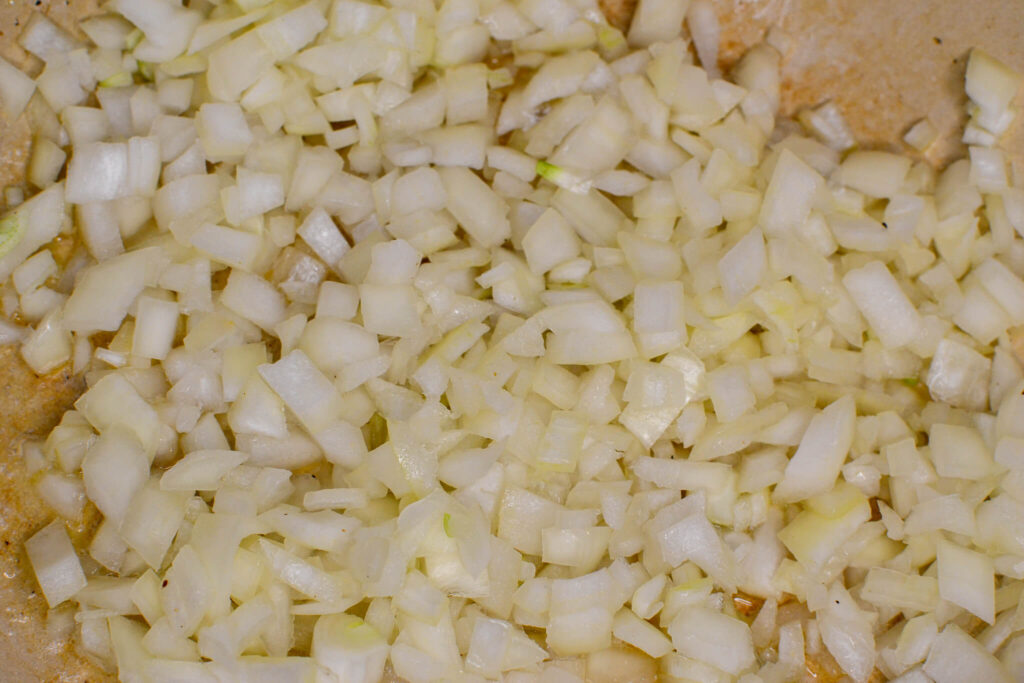
When sautéing onions for this recipe, cook them until they turn soft and translucent. This change in texture and color is key to bringing out their natural sweetness, which adds depth to the risotto’s flavor. This process, where the onions gently cook and sweeten, is crucial for creating a rich base for the dish.
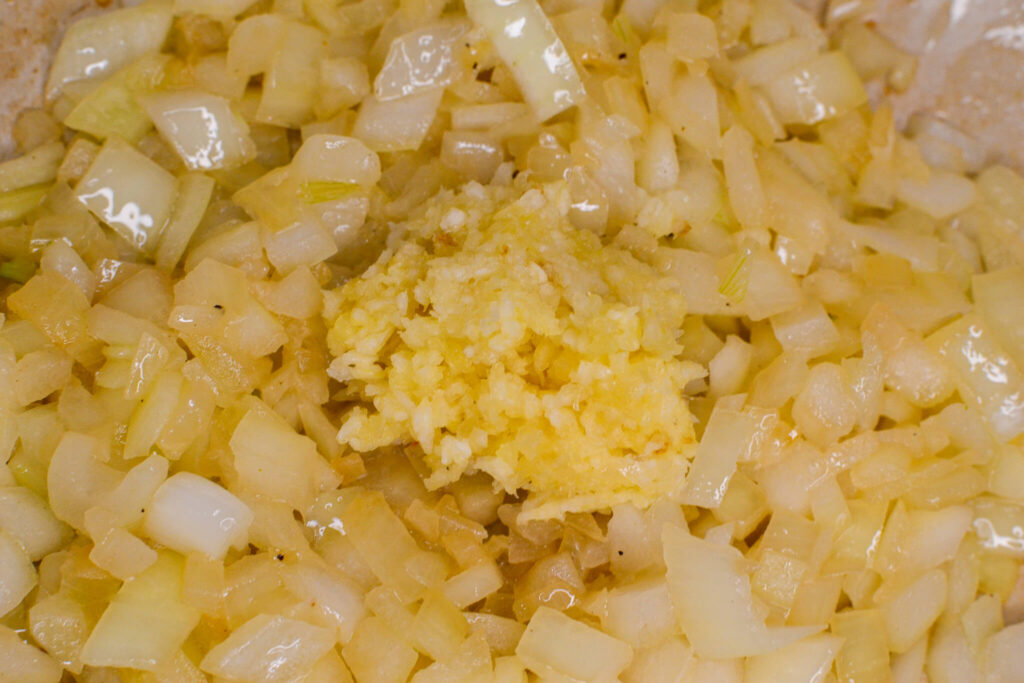
For this recipe, be careful when adding the garlic. Cook it until it starts to smell good, which should take about a minute. This keeps it from getting bitter and helps it add to the sweetness of the onions, making the risotto taste better.
Step 3
Cook Rice & Add Liquids
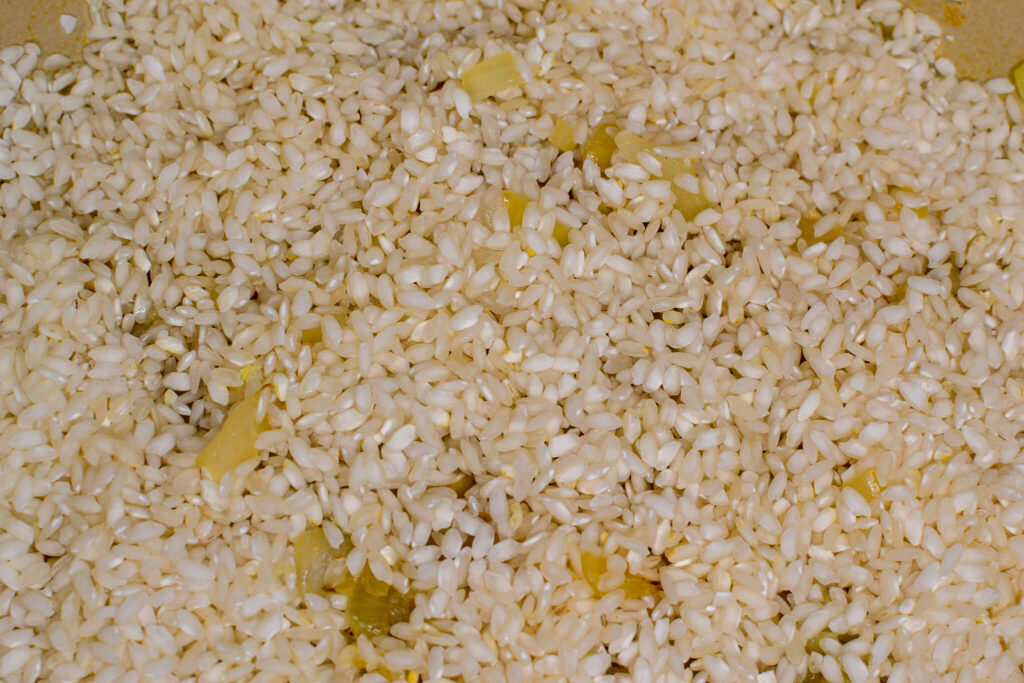
Now, let’s focus on the risotto itself. Start by toasting the Arborio rice in the same pan where you cooked the onions and garlic. This step is crucial as it coats each grain in the flavorful base, adding depth to the dish.
Arborio rice, a staple in Italian cuisine, key for making traditional risotto. It comes from the Arborio area in Italy and is known for its short, fat grains and lots of starch, mainly amylopectin. This is what gives it a creamy texture when cooked.
Arborio rice’s special feature is that it can soak up liquids and flavors but still keep a firm, chewy middle, called ‘al dente’ in Italian cooking. The mix of creamy texture and a bit of bite is what makes a good risotto.
When you cook Arborio rice, it slowly lets out its starch, making the liquid around it thicker and giving risotto its creamy texture. This happens more when you cook risotto by slowly adding warm broth to the rice, letting each grain soak up the liquid and release starch.
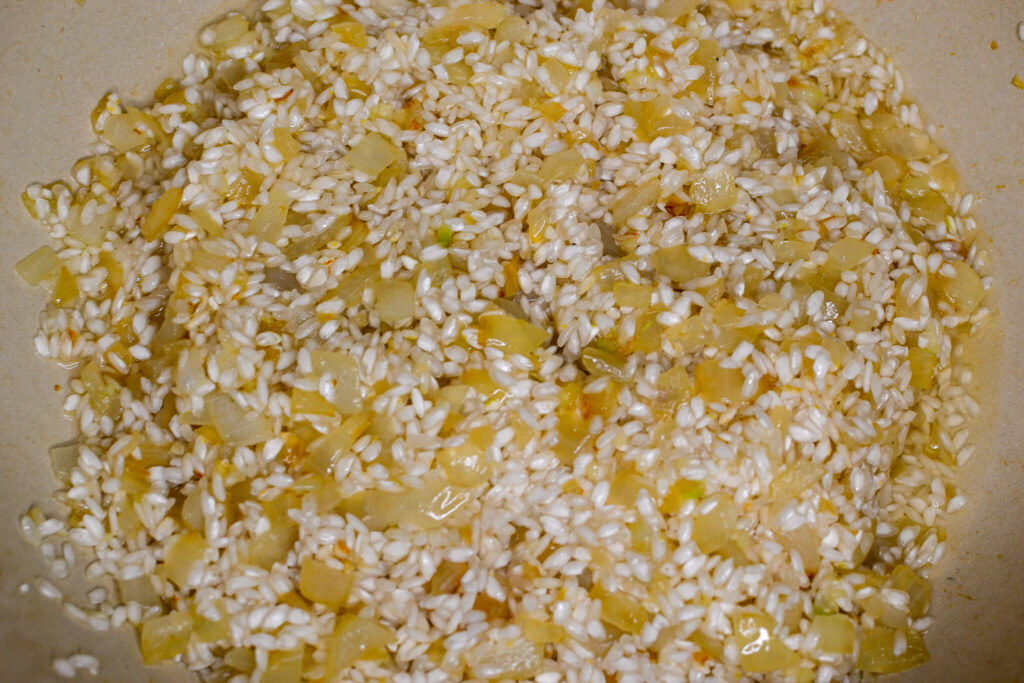
Then, pour 3/4 cup of white wine into the rice. The wine adds a light acidity that improves the risotto’s flavor. Wait for the rice to completely soak up the wine before you add anything else. This not only fills the rice with the wine’s scent but also makes it better at absorbing the broth later.
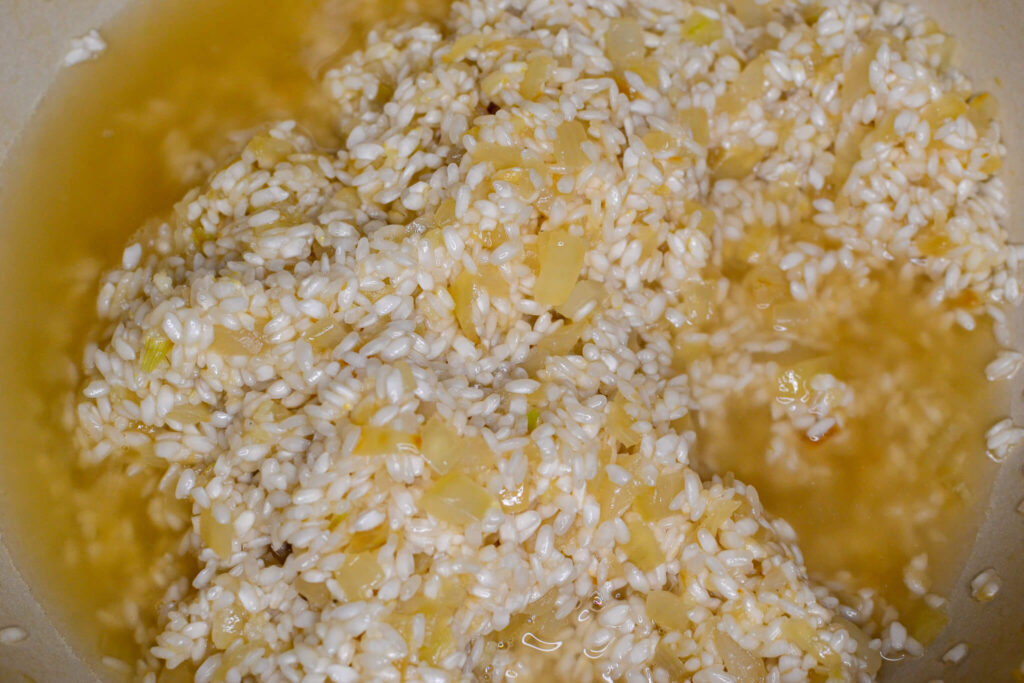
Next, begin to slowly add warm vegetable stock to the rice. This important step in making risotto requires patience and careful attention. Add the stock little by little, stirring constantly. This slow soaking process is key to getting the creamy texture that a good risotto is known for.
Vegetable stock, which is lighter and has more aroma than chicken broth (though chicken broth is also a good choice), adds a subtle flavor and makes the dish vegetarian-friendly. Make sure to keep the stock simmering, because adding cold stock can shock the rice, changing its texture and how it cooks.
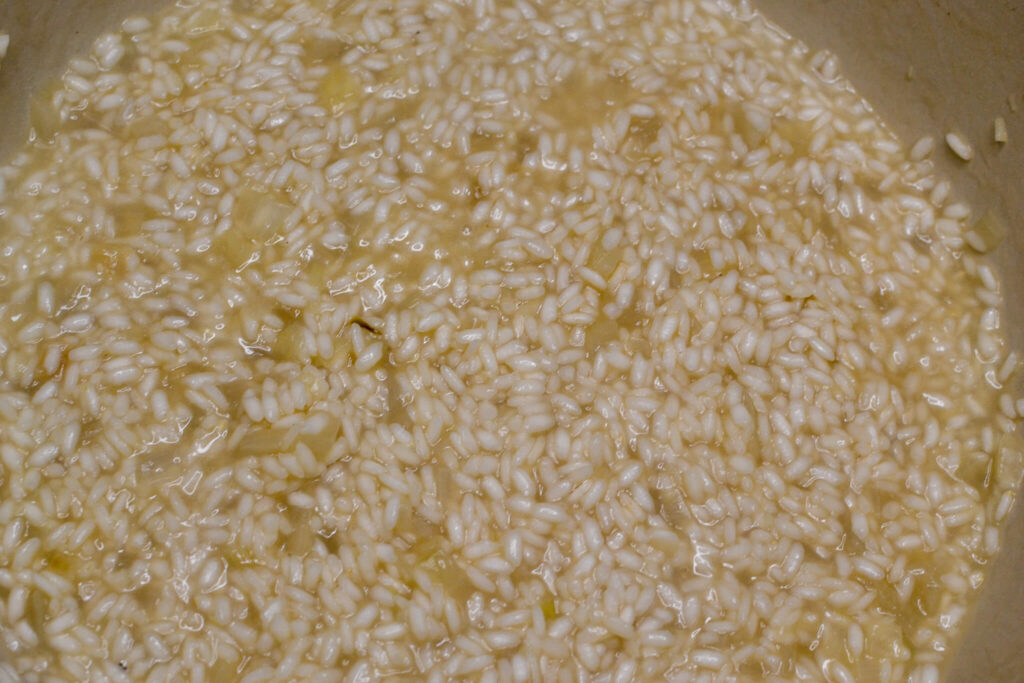
Stirring the rice while adding liquid is very important in making risotto. It helps in two main ways. First, it keeps the rice from sticking to the pan and burning. Second, and most importantly, stirring helps release the starch from the rice. This starch mixes with the liquid and makes the risotto creamy. Also, stirring makes sure that the rice cooks evenly and soaks up the flavor of the broth or stock well. If you don’t stir enough, the risotto might not be as creamy, could cook unevenly, and might not taste as good.
It will typically take around 15 minutes for the rice to fully absorb all the liquid.
Step 4
Add Cheese & Lemon
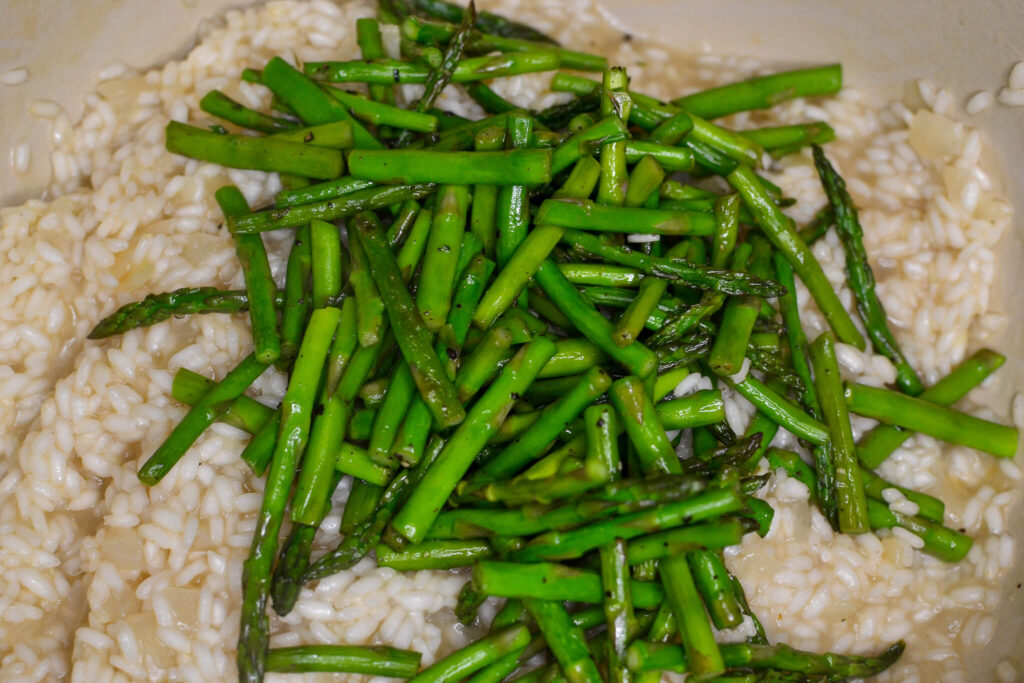
As the risotto is almost ready, with the rice becoming tender and al dente, it’s the perfect time to add the asparagus back in. If you feel the asparagus pieces are too large at this point, you can conveniently cut them smaller directly in the pan you used for sautéing.
This method is efficient and saves extra cleanup. Just stabilize the pan and carefully cut the asparagus to your desired size. This way, you can seamlessly blend the asparagus into the risotto, ensuring its vibrant green color and fresh flavor are evenly distributed throughout the creamy rice. It’s a simple adjustment that can make a big difference in the texture and presentation of your dish
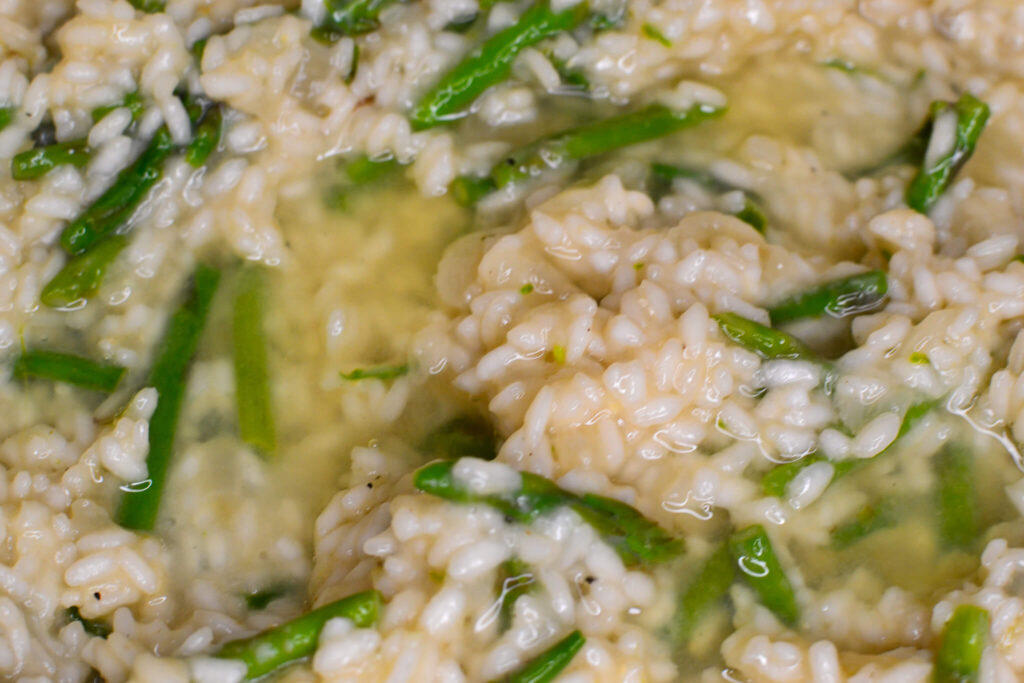
Add 2 tablespoons of lemon juice to the risotto and consider adding lemon zest for extra flavor. Just make sure not to use too much, as it can overpower the other ingredients. The lemon juice adds freshness and helps balance the richness of the cheese and butter. It also enhances the asparagus, giving it a slight tang.
Remember to add the lemon juice in moderation. 2 tablespoons is usually plenty but you can adjust to your taste. This way, you’ll keep the flavors in your risotto balanced and enjoyable.
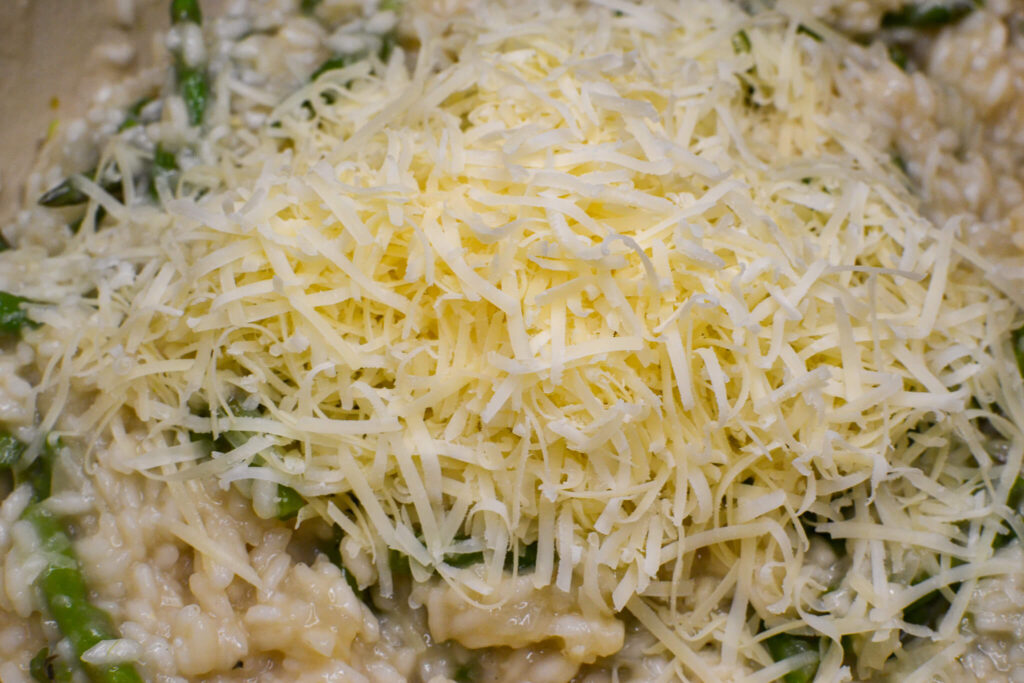
Stir generous amount of grated Parmesan cheese into the risotto. This is a key step in the recipe. Parmesan cheese is known for its rich, salty flavor and a hint of nuttiness, which brings a depth of umami to the dish. It’s this umami quality that gives the risotto a savory complexity.
As you mix in the cheese, it melts into the risotto, further enhancing the creamy texture. The amount of cheese can vary according to your taste, but a good starting point is about half a cup. Be sure to taste as you go and adjust accordingly. This step not only adds flavor but also contributes to the rich, creamy consistency that risotto is famous for.
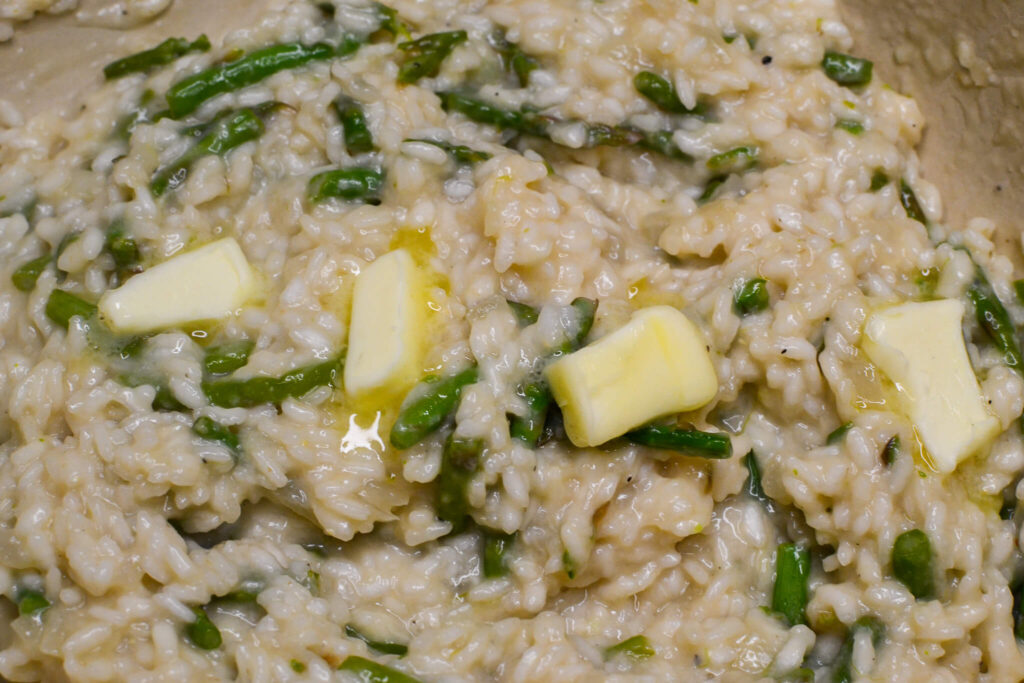
After the Parmesan, put in a knob of butter, which is about two tablespoons. Adding butter at the end, a step known in cooking as ‘mounting with butter’, is crucial for a smooth, rich finish. Stir the butter gently until it melts completely and mixes in. This not only makes the risotto taste richer but also gives it a shiny, inviting look.
The butter goes well with the Parmesan, balancing the flavors and making each spoonful of risotto creamy and luxurious. This last step turns the risotto into a well-blended, satisfying dish that feels both cozy and upscale.
Lastly, season to taste with salt and pepper to give the risotto some more flavor.
Step 5
Enjoy Your Asparagus Risotto!
And there you have it, your creamy, flavorful asparagus risotto recipe, ideal as a side dish, is ready for enjoyment. Serve the risotto while it’s warm to fully appreciate its best texture and taste.

American Beauty

Inspiration
“Can Someone Please Pass The Fucking Asparagus?” – Lester Burnham

More About Asparagus Risotto
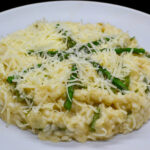
Asparagus Risotto
Ingredients
- 1 pound Asparagus
- 1 Lemon
- 1 Sweet Onion
- 2 Garlic Cloves
- 1/2 cup Parmesan Cheese
- 2 tbsp Butter
- 2 cups Arborio Rice
- 3/4 cup White Wine
- 4 cups Vegetable Stock
- 4 tbsp Olive Oil
- 1/2 tsp Salt
- 1/2 tsp Black Pepper
Instructions
Prep & Cook Asparagus
- Trim and chop 1 pound of asparagus into bite-sized pieces.
- Sauté the asparagus in butter and olive oil for 3-5 minutes, then season with salt and pepper. Set aside.
Prep & Cook Onions/Garlic
- In the same pan, sauté the chopped sweet onion in butter and olive oil until soft and translucent. Add minced garlic and cook for 1 minute until fragrant.
Cook Rice & Add Liquids
- Add the Arborio rice to the pan, stirring to coat the grains.
- Pour in 3/4 cup white wine and let it absorb.
- Gradually add 4 cups of warm vegetable stock, one ladle at a time, stirring constantly until the rice is creamy and cooked, about 15 minutes.
Add Cheese & Lemon
- Stir in 1/2 cup Parmesan cheese, 2 tbsp butter, and 2 tbsp lemon juice.
- Add the cooked asparagus back into the risotto. Adjust seasoning with salt and pepper.
Enjoy Your Asparagus Risotto
- Serve warm and garnish with extra Parmesan if desired. Enjoy the rich, creamy flavors of your homemade risotto!
This dish has its roots in the rich culinary traditions of Northern Italy. The story of risotto begins with the introduction of rice in Italy, likely brought over by the Arabs during the Middle Ages. It found a perfect growing environment in the humid and water-rich regions of Northern Italy, especially in Lombardy and Piedmont.
Over time, Italian cooks mastered the art of risotto, a method of cooking rice that highlights its natural starches. This technique involves slowly cooking short-grain rice, like Arborio, in broth until it achieves a creamy consistency, perfectly balancing tenderness and bite.
The incorporation of asparagus into risotto is a testament to Italian cooking’s emphasis on seasonal and fresh ingredients. Asparagus has been valued since ancient times, both for its distinct flavor and nutritional benefits. In Italy, the arrival of spring brings fresh, tender asparagus to the markets, signaling a perfect time to blend this vegetable with creamy risotto.
As a result, this dish became a popular dish that combines creamy rice with fresh asparagus. This dish showcases the Italian way of cooking, which focuses on simple, high-quality ingredients and using what’s in season.

